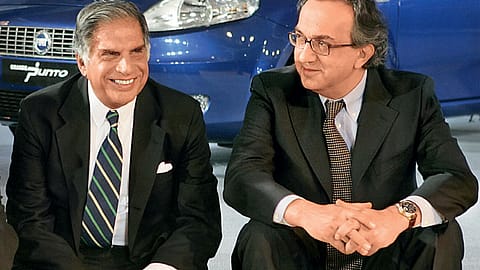Marchionne's next challenge
It will take more than time to fix Fiat India. It needs an encore from the group’s turnaround artist.

SEPTEMBER IN DELHI isn’t chilly but Fiat SpA CEO Sergio Marchionne sticks to his trademark dark sweater, looking more like a sidewalk-cafe intellectual than a world-famous turnaround executive. He’s here for the Society of Indian Automobiles’ annual convention. It’s 2008 and he’s not running Chrysler yet.
Marchionne is casual, pulling on a cigarette in the lobby of the Ashok in Delhi, as he talks about the new Fiat India. The Rs 4,000 crore “Ranjangaon (plant, in Maharashtra) was my idea,” he says. Like every other auto company back then, Fiat was already seeing India as the next big car bazaar. In fact, it had signed a 50:50 joint venture agreement with Tata Motors the previous year.
Some of Marchionne’s touches have since been evident here. Like the flair with which Fiat began its image makeover. First, in 2008, came the iconic Fiat 500 followed by the Linea sedan and the Punto in 2009. Total sales to date: 40,000 units, of which 24,000 were sold in 2009.
By Fiat’s standards, these numbers are impressive. In the last decade, Fiat India’s plans have invariably stuttered, though its association with India goes back to 1959 when it partnered Premier Automobiles, an arrangement that lasted till 1998. Indeed, Fiat India officials see 2007 as a fresh start and argue that any comparison with the past is meaningless. But, Fiat still isn’t a company to reckon with: partner Tata Motors sold 24,000 cars this June alone.
“The whole thing with Fiat’s coming and then going, the different partners, launching cars and then yanking them off the market … it’s going to take a couple of years to get that image out of people’s minds,” says Abdul Majeed, auto practice leader with PricewaterhouseCoopers (PwC) India.
In other words, Fiat India could do with a little more of Marchionne’s magic.
Though he hasn’t been back since 2008—Ford CEO Alan Mulally and Renault-Nissan top boss, Carlos Ghosn, have visited India twice in this period—Rajeev Kapoor, Fiat India’s CEO, says Marchionne’s not disconnected. “He reviews India on a regular basis.” (A scheduled trip last year got postponed.) That may explain why Paolo Gagliardo, EVP of international operations and one of Marchionne’s direct reports, was in India this July. As Kapoor puts it, Fiat’s strategy isn’t just shaped by what its Turin HQ thinks, but also by market realities. Figuring that out was Gagliardo’s brief. Some of the things he did: check out consumer preferences and used car sale patterns, visit dealers, etc.
According to PwC Autofacts, the auto sector grew at 26% over 2009. By 2011, India should be at 3.3 million vehicles—the world’s sixth largest market. Fiat’s core competency in mid-size sedans and small cars will be a boon then, given they comprise over 80% of the market. Even if Fiat tripled sales by end-2011—assuming the Ranjangaon plant with an initial annual capacity of 70,000 cars, scaleable to 200,000 kicks into gear—its market share will be under 5%. Time for the turnaround artist to come up with another good idea?